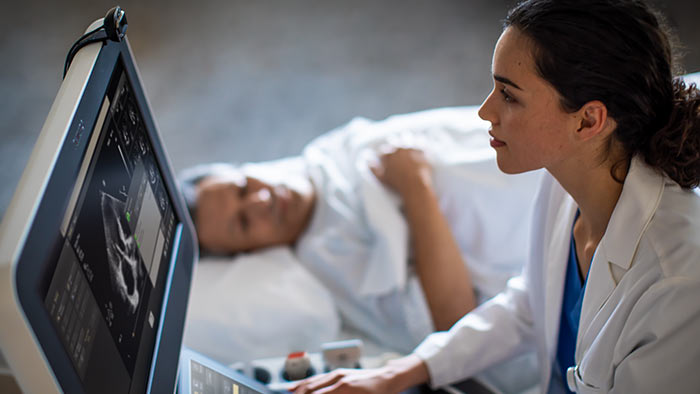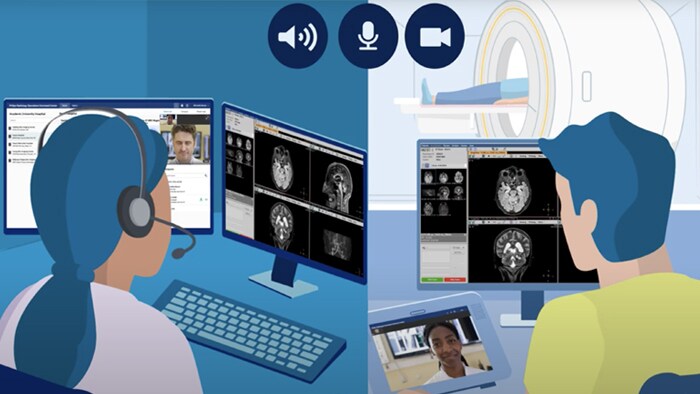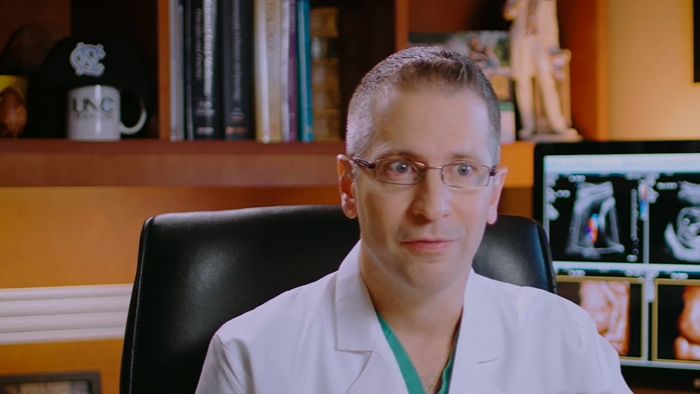Radiology
What if your imaging team could access expert support for complex procedures and protocols whenever they need it?
Qualified imaging technologists and tech managers are already in short supply – and the forecast for meeting the increasing demand is not optimistic.1 To make things worse, training programs are not filling the funnel with new techs. What if you could provide the expert diagnostic quality support your team needs – on demand – exactly when they need it? What if you could offer greater access to care by extending your team rather than expanding it? And what if you could take advantage of expert clinical consults and diagnoses in closed environments such as COVID wards, without summoning those high-demand specialists to the bedside?

At a glance
Challenge
Complex protocols and advanced imaging cases call for experienced technologist support. But specialist expertise is not always on premise – or on duty – when you need it. Physical distance not only separates imaging teams from expert guidance, but too often also keeps patients from accessing expert care. With experience and expertise at a premium, imaging teams need ways to make those skills go further.
Results
Share this article
Imaging teams are under more and more pressure
Up to 50% of radiography programs are not fully enrolled2, and workforce shortages have strained radiology services while the need for imaging studies continues to grow.3 You’re living this every day. Increasing demands of care systems put added pressure on already-stretched imaging teams. The complexity of technology and cases makes challenges with staffing, skill variability and quality standardization more apparent than ever.

3 out of 5⁴
technologists want more on the job training

3 out of 5⁴
lead technologists want more imaging protocol standardization

4 out of 5⁴
imaging respondents believe an imaging telepresence solution would add value
How care transforms when physical distance is no longer an obstacle
Now a technologist can receive expert guidance in real time during a procedure, even if the technologist and expert are on separate floors, in separate buildings, or thousands of miles apart. The less time clinical experts need to spend traveling between the locations they support, the more time they can devote to performing the specialized capabilities for which they’ve trained.
I love the fact that every time I see a connection, I know that I'm improving quality and consistency and the fundamental principle of ‘let's get the exam right the first time’.... This is really one of the most quality-focused, impactful tools that we've had.”
Dr. Lawrence Tanenbaum
VP, Chief Technology Officer and Director of Advanced Imaging, RadNet, Inc., U.S.
Expand access to care
Patients – whether in rural areas, in quarantine conditions, or with limited mobility – can benefit from greater access to expert care. When imaging providers can offer complex procedures at more locations, closer to where patients live, and at more flexible hours it means less hassle and more convenience for patients. It's made possible by the confidence that trained experts are available on demand to provide “over-the-shoulder” support as if physically present.
Results
Remote expert support is changing what’s possible with imaging today. See the success that Perinatal Associates of New Mexico is having with tele-ultrasound.
100%
of ultrasound patient consultations could be conducted using tele-health in this study5
100%
of patients felt they had better access to healthcare through tele-health in this study5
90%
of tele-ultrasound consultations were equivalent to an in-person visit, based on physician assessment5
Go deeper
Are you interested in learning more about how these solutions can help you address your challenges?
Optimize your imaging network
Real-time remote diagnosis and guidance
Webinar
Early adopters share their success in “Going Remote”.
Share this article
At a glance
Challenge Complex protocols and advanced imaging cases call for experienced technologist support. But specialist expertise is not always on premise – or on duty – when you need it. Physical distance not only separates imaging teams from expert guidance, but too often also keeps patients from accessing expert care. With experience and expertise at a premium, imaging teams need ways to make those skills go further.
Results
Would you like to know more about ways your team could access expert imaging support whenever needed?
Take a deeper look at the solutions that are helping radiology departments promote efficiency and confidence in image acquisition.
*Accessible via compatible clients including iOS, Android, Chrome web browser and Windows with release 9.0 or higher


